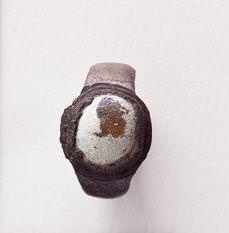Jewellery
A considerable number of jewels such as personal ornaments found on the deceased come from the Cornus necropolises: mainly rings, necklaces and beads, armillas and earrings.
They found rings decorated with snakes, symbol of good and evil; on one, interpreted as a wedding ring from t. 115, the engraved letters of a monogrammed cross (fig. 1). Then, during digs in tombs dated between the IV and start of the VII A.D., they found rings in a flat band or with bezel and gems (figs. 2-3). At times the decoration had Christian and pagan symbols, but the recovery of Punic gold-working is obvious.



Then several beads in various shapes and materials (amber, glass paste, gemstones and terracotta) recovered inside and outside the tombs perhaps forming necklaces, bracelets or used as amulets. Along with an example of amber necklace (fig. 4), they found clips proving use to close the sequence of gems.

Of special significance the finding of glass armillas in some tombs, an item category rarely found in Sardinia but widely documented in the East between the III and VII century A.D. Two bronze bracelets with open ends (fig. 5) found in tomb 102, dated between the VI and VII century and referable to a type used a lot in the early Middle Ages in both Byzantine necropolises and in the Lombard culture.

The earring types found in Cornus show the influence of new Germanic models (fig. 6) and Byzantine ones and, at the same time, still linked to Phoenician-Punic and Roman traditions. Those jewels were found in all the stages of the cemetery area, that is from the end of the IV to the VII century A.D.

Bibliografia
- C. AMANTE SIMONI, I corredi altomedievali (II metà del VI-VII secolo), in C. AMANTE SIMONI, R. MARTORELLI, I corredi funerari e la suppellettile metallica. Cultura, Materiali e Fasi Storiche del Complesso Archeologico di Cornus. Primi risultati di una ricerca, in AA.VV., L'archeologia romana e altomedievale nell'Oristanese. Atti del Convegno di Cuglieri (22-23 giugno 1984) = Mediterraneo tardoantico e medievale, Scavi e ricerche, 3, Taranto 1986, pp. 171-177, catalogo nn. 153-154, pp. 187-189.
- C. AMANTE SIMONI, I corredi, in C. AMANTE SIMONI, A. M. GIUNTELLA, L. PANI ERMINI, D. STIAFFINI, Ricerche di archeologia post-classica nella Sardegna centro-medievale, in Quaderni della Soprintendenza Archeologica per le Province di Cagliari e Oristano, 4, II, 1987, pp. 83-86.
- C. AMANTE SIMONI, R. MARTORELLI, I corredi funerari e la suppellettile metallica. Cultura, Materiali e Fasi Storiche del Complesso Archeologico di Cornus. Primi risultati di una ricerca, in AA.VV., L'archeologia romana e altomedievale nell'Oristanese. Atti del Convegno di Cuglieri (22-23 giugno 1984) = Mediterraneo tardoantico e medievale, Scavi e ricerche, 3, Taranto 1986, pp. 161-189.
- CUGLIERI I = AA.VV., L'archeologia romana e altomedievale nell'Oristanese. Atti del Convegno di Cuglieri (22-23 giugno 1984) = Mediterraneo tardoantico e medievale, Scavi e ricerche, 3, Taranto 1986.
- R. MARTORELLI, I corredi tardo-romani (IV - prima metà del VI secolo), in C. AMANTE SIMONI, R. MARTORELLI, I corredi funerari e la suppellettile metallica. Cultura, Materiali e Fasi Storiche del Complesso Archeologico di Cornus. Primi risultati di una ricerca, in AA.VV., L'archeologia romana e altomedievale nell'Oristanese. Atti del Convegno di Cuglieri (22-23 giugno 1984) = Mediterraneo tardoantico e medievale, Scavi e ricerche, 3, Taranto 1986, pp. 161-170, catalogo pp. 178-186.
- R. MARTORELLI, Persistenze puniche nei corredi funerari tardoantichi ed altomedievali del complesso di Cornus (S. Caterina di Pittinurri-Oristano), in A. MASTINO (a cura di), L’Africa romana. Atti del VII Convegno di studio (Sassari, 15-17 dicembre 1989), Sassari 1990, pp. 538-548.
- R. MARTORELLI, I materiali metallici e gli oggetti di corredo, in A. M. GIUNTELLA (a cura di), Cornus I. 2. L'area cimiteriale orientale. I materiali = Mediterraneo tardoantico e medievale, 13. 2, Oristano 2000, pp. 23-50.
- R. MARTORELLI, Artigianato metallico nella Tardantichità e nell’Altomedioevo in Sardegna, in Associazione culturale Filippo Nissardi (a cura di), Architettura, arte e artigianato nel Mediterraneo dalla Preistoria all'alto Medioevo. Atti della Tavola rotonda internazionale in memoria di Giovanni Tore (Cagliari, 17-19 dicembre 1999), Oristano 2001, pp. 377-393.
- R. MARTORELLI, Documenti di cultura materiale pertinenti agli scambi commerciali e alle produzioni locali, in P. CORRIAS, S. COSENTINO (a cura di), Ai confini dell’impero: storia, arte e archeologia della Sardegna bizantina, Cagliari 2002, pp. 137-148.
- R. MARTORELLI, Usi e consuetudini funerarie nella Sardegna centro-occidentale fra tarda antichità e alto Medioevo, in P. G. SPANU, R. ZUCCA (a cura di), Oristano e il suo territorio, 1. Dalla preistoria all’alto Medioevo, Roma 2011, pp. 701-759.

 VR
VR